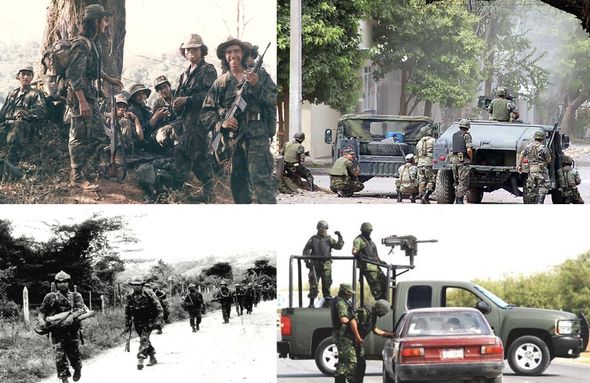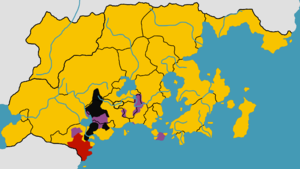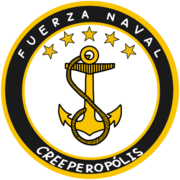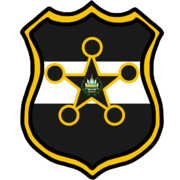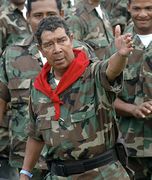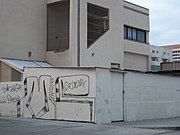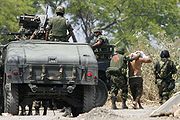Mara War
The Mara War (Creeperian Spanish: Guerra Mara or Guerra de Maras or Guerra Contra las'Maras), also called the Creeperian Drug War (Creeperian Spanish: Guerra de Drogas Creeperiano) is a major ongoing civil military conflict raging in Creeperopolis between the government of the nation and the notorious criminal and terrorist gang known as Mara Salvatrucha (abbreviated as MS). The war is the deadliest ongoing global conflict with a total death toll of anywhere from 1,730,000 deaths to upwards of 2,394,000 deaths.
The war began on October 15, 1979, on the orders of Emperor Adolfo V as an operation to eliminate the long existing gang from Creeperopolis and to curb its influence in Creeperian culture as many young Creeperans joined the gang. At first, the gang sought only to survive, but as the war dragged on and intensified, the gang began to seek the toppling of the government.
The Creeperian government's primary goals are the elimination of Mara Salvatrucha, the end of the illegal drug trade in Creeperopolis, the arrest of all members of the gang, and the cessation of all domestic and international gang activities. The government resorted to all means to fight the gang and the government has been constantly accused of using chemical weapons against gang members and even suspected gang memebrs. The government allowed for several death squads to freely operate in the country to fight against the gang. Such notorious death squads include the Militarist Nationalist Front, the Movement of Organized Nationalist Action, and the Creeperian Catholic Protection Army. Ten death squads formed the Anti-Deltinian Armed Forces of Liberation - War of Elimination in 2020 and continue to fight soley the gang and not the government. Both the Creeperian Armed Forces and the Creeperian National Police are engaged in the war against the gang.
On the other hand, the primary goals of Mara Salvatrucha are the toppling of the Creeperian government and its replacement with a Mara-sympathetic government to allow the group to carry out its domestic and international crime spree. Mara Salvatrucha allied itself with the Republic of Senvar and its military wing, the Senvarian Liberation Front, groups that have been rebelling against the Creeperian government in the Third Senvarian Insurgency since 1934 during the Creeperian Civil War. The gang also allied itself with the Castillianan National Council of Reorganization and its own military wing, the Militarist Front for National Liberation, who took up arms against the Creeperian government in 1980 in the Castillianan Insurgency, and later with the Army for the Rescue of Lyoa and the Free Lyoan Army. Since the dawn of the twenty-first century, Mara Salvatrucha has restorted a more terroristic approach to its war committing several terrorist attacks, most notably the 2020 Creeperian Attacks on March 18, 2020, killing 87 people.
Currently, an automatic penalty of 70 years imprisonment is to be handed down to any captured member of Mara Salvatrucha, reduced from an death sentence in 1987. Meanwhile, an automatic death penalty is to be handed down to any captured Mara Salvatrucha leader. The penalty may be carried out extrajudicially by the arresting officers if they so choose or may be carried out officially by the government.
Contents
- 1 Background
- 2 Armed Conflict
- 3 Creeperian Government Forces
- 4 Mara Salvatrucha
- 5 Paramilitaries and Death Squads
- 5.1 Armed Resistence Militia for Creeperopolis
- 5.2 Creeperian Armed Nationalist Front
- 5.3 Creeperian Catholic Protection Army
- 5.4 Creeperian Revolutionary Militarist Patriotic Front
- 5.5 Militarist Nationalist Army
- 5.6 Militarist Nationalist Front
- 5.7 Militarist Nationalist Milita
- 5.8 Militarist Revolutionary Front
- 5.9 Movement of Organized Nationalist Action
- 5.10 Revolutionary Militia for Creeperian Sovereignty
- 5.11 Leadership
- 6 Propaganda
- 7 Effects in Creeperopolis
- 8 Effects Internationally
- 9 See Also
Background
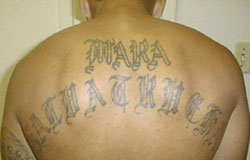
Mara Salvatrucha, popularly known as "MS" or "la'Mara", is an Creeperian criminal gang that originated in San Salvador, San Salvador, Creeperopolis in 1951. Originally, the gang was set up to raid stores and homes for basic living needs for young survivors of the Creeperian Civil War. Over time, the gang grew into a more traditional criminal organization. Mara Salvatrucha is defined by its cruelty and brutality. The gang is currently active in many parts of Creeperopolis. Most members are Creeperans, Castillianans, Senvarians, Sonsatepanians, and Deltinians. As a national gang, its history is closely tied to Creeperian history.
Notable activities conducted by Mara Salvatrucha include drug trafficking, robbery, larceny, human trafficking, extortion, murder, embezzlement, money laundering, prostitution, racketeering, battery, kidnapping, armed insurrection, and arms trafficking.
Meanwhile, the illegal drug trade in Creeperopolis concerns primarily the production and sale of cocaine, methamphetamine, heroin, and cannabis, including the export of these substances to foreign nations. The cultivation of the materials used to produce these drugs are extremely common in southern Creeperopolis, particularly in the so-called "Zapatista Triangle" where most of the substances are created and exported from.
Drug consumption in Creeperopolis remains relatively low due to extremely harsh punishments against its use, but cocaine in particular has increased in recent years in countries along the major smuggling routes. As of 2020, drugs are primarily smuggled to Lyoa, Rakeo, Terranihil, Malgax, San Carlos Islands, and Willdavie, will little smuggling being reported elsewhere.
The largest drug trafficking organization is Mara Salvatrucha, but the Senvarian Liberation Front and the Militarist Front for National Liberation were also major smugglers while they were active.
As a result of the concentration of drug trafficking, Creeperopolis has the world's highest crime rates, with murder reaching 10.65 per 100,000 of population in 2020, the highest in the world. Violence has surged in Creeperopolis since 1979 when Emperor Adolfo V began the Mara War against Mara Salvatrucha.
Armed Conflict
Under Adolfo V
Part of a series on the |
|---|
| History of Creeperopolis |
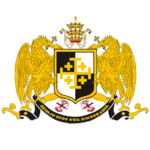 |
|
|
Declaration of War
Since the foundation of Mara Salvatrucha in 1951, the gang has increasingly gained more influence and members, particularly in the departments of Abdan, Helam, Jakiz, San Pedro, San Salvador, Senvar, Sonsatepan, and Zapatista, with Zapatista being the department where the gang held the most influence. The rise in gang membership led to a rise in crime, particularly drug trafficking, murder, and robbery.
With the significant rise in crime, the Creeperian government needed to do something to curb the gang's power and influence in the country. On October 15, 1979, the Council of Mayors proposed a motion to utilize the Creeperian Armed Forces and the Creeperian National Police to eliminate the gang and its power and influence. The motion was passed unanimously and was submitted to Emperor Adolfo V who signed the motion into law. The motion, called A Motion for the Eradication of Mara Salvatrucha, called for the Creeperian Armed Forces and the Creeperian National Police to arrest and aprehend all gang members of Mara Salvatrucha.
In retaliation, Mara Salcatrucha leadership declared war on the government on October 16, 1979. Mara Salvatrucha leadership sought support from the other significant warring party engaed in open combat with Creeperopolis: the Republic of Senvar. The Senvarians accepted and both Mara Salvatrucha and the Senvarian Liberation Front began fighting side by side against the Creeperian government.
Enter Castillianans
The year following the break out of war between the government, the Castillianan Insurgency began with the Castillianan National Council of Reorganization declaring total independence for the Creeperian department of Castilliano. The Castillianan National Council of Reorganization and its military force, the Militarist Front for National Liberation, allied itself to both the Senvarian Liberation Front and Mara Salvatrucha. The Castillianans were lead by Farabundo Martí Rodríguez.
Tuxtla Martínez Massacre
On August 5, 1985, members of Mara Salvatrucha attacked the capital city of the department of Zapatista, the city known as Tuxtla Martínez, named in honor of the ruling House of Martínez. The ensuing massacre killed 1,384 people, most of whom were civilians. The gang was immediately blamed for the attack.
Later Years
In the last years of the reign of Adolfo V, Mara Salvatrucha gained significant control of territories in the departments of Abdan, Castilliano, Deltino, Helam, San Pedro, San Salvador, Senvar, Sonsatepan, and Zapatista, with the gang itself being headquartered in Zapatista.
It was around this time that eight death squads formed to combat the rise of Mara Salvatrucha:
| Death Squad | Creeperian Spanish | Founded | Reason for Foundation |
|---|---|---|---|
| Militarist Nationalist Army | Ejército Nacionalista Militarista ENAMI |
1979 | Elimination of Mara Salvatrucha. |
| Militarist Nationalist Militia | Milicia Nacionalista Militarista MINAMI |
1980 | Uphold Creeperian Nationalism and the elimination of Mara Salvatrucha. |
| Creeperian Revolutionary Militaristic Patriotic Front | Frente Patriotico Militarista Revolucionario Creeperiano FPMRC |
1983 | Uphold Creeperian Nationalism and the elimination of Mara Salvatrucha and the Senvarian Liberation Front. |
| Movement of Organized Nationalist Action | Movimiento de Acción Nacionalista Organizado MANO |
1983 | Uphold Creeperian Nationalism and the elimination of Mara Salvatrucha. |
| Revolutionary Militia for Creeperian Sovereignty | Milicia Revolucionario por'Soberanía Creeperiano MIRESOC |
1983 | Uphold Creeperian Nationalism and the elimination of Mara Salvatrucha. |
| Militarist Revolutionary Front | Frente Revolucionario Militarista FREMI |
1985 | Elimination of Mara Salvatrucha. |
| Creeperian Catholic Protection Army | Ejército Católico Creeperiano de Protección ECCP |
1987 | To protect Creeperian Catholics from the spread of Mara Salvatrucha and the Senvarian Liberation Front. |
| Creeperian Armed Nationalist Front | Frente Nacionalista Armada Creeperiano FRENARC |
1989 | Eliminate the influcence of Mara Salvatrucha and the Senvarian Liberation Front. |
The eight death squads that formed created a loose alliance with each other and with two other previously existing death squads (the Militarist Nationalist Front, Frente Militarista Nacionalista, FRENAMI, 1940, and the Armed Resistance Militia for Creeperopolis, Milicia Revolucionario Armada Creeperiano, MIRAC, 1970) to join forces to eradicate Mara Salvatrucha.
The Creeperian government did little to nothing to prevent the death squads from taking any extrajudicial and vigilante measures against Mara Salvatrucha, and some sources even claim the Creeperian government was complacent or even supporting and encouraging of the death squads' actions and activities.[citation needed] The Creeperian government denied and continues to deny these accusations of support for death squads.
Under Romero III
Assassination of Archbishop Romero Galdámez Alas
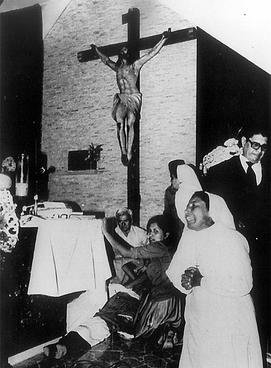
Emperor Adolfo V died on February 28, 1987, leading to the ascension of his brother, Romero III, to the Creeperian throne. Mara Salvatrucha planned to assassinate the new Emperor and the Archbishop of San Salvador, Romero Galdámez Alas, at the same time to scare the Creeperian people and force a government concession.
On Sunday March 22, 1987, six gunmen from Mara Salvatrucha arrived at the Basilca of Christ the King and opened fire on the congregation, knowing that both the Archbishop and Emperor would be in attendance. Archbishop Galdámez Alas was killed along with 39 worshipers with 71 more being wounded. The gunmen attempted to flee but a Creeperian Army patrol truck opened fire. In the ensuing shootout, all six gunmen were killed and 3 soldiers were wounded. The Emperor, however, was not present as he attended an earlier mass.
Following the assassination, Emperor Romero III called upon the deaths of all members of Mara Salvatrucha for this unforgivable crime against God. He declared that all members of the gang, regardless of their age, gender, or ranking, are to be immediately put to death or are to be handed over to the government for an immediate execution. Later that year, the death penalty for low ranking members was reduced from death to 70 years imprisonment.
Operation Galdámez Alas
On March 22, 1989, the Creeperian Army and the Creeperian Air Force began a large scale assault on Mara held territory in Zapatista. The operation was named after Romero Galdámez Alas and began on 2 year anniversary of his assassination. The bombing campaign ended on March 25 and the army advanced on territory on March 26. Mara Salvatrucha resorted to guerrilla warfare to halt the advance. In the end, the operation was indecisive as the Creeperian Army did capture territory but failed to significantly weaken Mara Salvatrucha.
Motion on the Death Penalty
The Motion on the Death Penalty was a motion passed by a majority of the vote in the Council of Mayors which was signed by Emperor Romero III on May 18, 1991, which officially legalized the immediate death penalty on high ranking members of Mara Salvatrucha. In retaliation of the passage of the motion, Mara Salvatrucha bombed a mall in Adolfosburg killing 23 people. The bombing marked the first time that Mara Salvatrucha expanded its range outside of southern Creeperopolis.
Motion on the Situation Regarding Mara Salvatrucha
The Motion on the Situation Regarding Mara Salvatrucha was a motion passed by a majority of the vote in the Council of Mayors which was signed by Emperor Romero III on August 19, 1993, which mandated the removal of citizenship of all members of Mara Salvatrucha and mandated that all members of Mara Salvatrucha had no constitutional rights.
Mapastepec Massacre


The village of Mapastepec was located in Mara controlled territory in the department of Zapatista along the shores of Lake Zapatista and the banks of the Zapatista River. The village was complaint with the Mara occupation and the gang used the village as a sort of base of operations in northeastern Zapatista. Due to the village's compliance with the gang, it was constantly threatened by death squad attacks, but nothing was ever committed.
In June 1998, a man with affiliations to the death squad known as the Creeperian Catholic Protection Army was lynched by the villagers of Mapastepec. The villagers attached a sign to the man reading "No death squads are welcome in Creeperopolis. Mara Salvatrucha is our protection from death." The event angered the leader of the Creeperian Catholic Protection Army, José Koné Ochelo. In anger, he ordered the immediate destruction of the village.
On the night of July 2 and 3, 1998, soldiers of the Creeperian Catholic Protection Army, several of whom were children, arrived at the village of Mapastepec and began burning homes, stores, and public buildings, sparing only the church. Men were shot in the head at point blank range, women were raped then shot point blank in the head, and children were either bayonetted to death or abducted as child soldiers. Those who took refuge in the church were rushed out at gunpoint to prevent the spillage of blood in the House of God. Those who refused where forcibly dragged out. Men were executed by a firing squad, women were raped and shot point blank, children were abducted as child soldiers, and those who resisted were drowned in the lake with heavy stones tied to their legs and arms. The entire village was burned to the ground except for the church. The soldiers of the Creeperian Catholic Protection Army withdrew into the jungles of Zapatista before dawn and returned to Santa Ana, the home department of the death squad.
In the end, 8,184 were killed and 195 children were reported to have been abducted by the Creeperian Catholic Protection Army as child soldiers. The Creeperian government denounced the massacre and Mara Salvatrucha was enraged.
In 2007, the Creeperian government exhumed the mass graves of thousands of the victims. The government stated that 4,185 bodies were recovered with very few being identifiable. The government stated that no effort will be made to recover drowned victims as it would be logistically difficult and that there is likely little remaining of the victims were were drowned.
Under Alfonso VI
Early Years
Emperor Romero II died on October 16, 1999. His brother, Alfonso VI, ascended to the throne and ushered in a period in Creeperian history known as the October 16 Regime, and it is also known as the Alfonsisto. The period was marked by totalitarian rule and neglect for the Creeperian population.
Cease Fire
On January 1, 2000, Alfonso VI signed a historic cease fire with Mara Salvatrucha where the Creeperian government promised to no longer arrest members of the gang nor execute any gang members in exchange for a cessation in the criminal activities of the gang. The cease fire was extremely unpopular with the citizens since Mara Salvatrucha continued to commit crimes. Many called for a coup but those who did were arrested and forcibly disappeared.
Under Alexander II
Coup
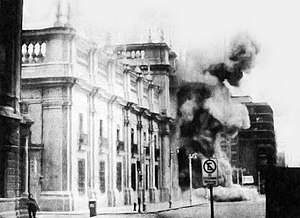
| ||
|---|---|---|
|
Emperor of Creeperopolis Reigning since 2003
Politics: Family: |
||
Beginning in February 2003, Chief Field Marshal Augusto Cabañeras Gutiérrez, Chief Admiral José Guerrero López, and Chief General Felipe Cambeiro Cavallería began meeting in secret to discuss a possible plot to overthrow the regime. The three approached the eldest son of Alfonso VI, Grand Prince Alexander Martínez Hernández, and asked him if he wished to join in on the plot to depose his father. After a large bribe and promises of power, Alexander Martínez Hernández joined aboard the plot. Each commander spoke to their respective soldiers to recruit them to the coup. After the military itself was brought onboard, a date was scheduled: June 18, 2003, would be the day the Creeperian Armed Forces overthrow the government of the Holy Traditionalist Empire of Creeperopolis.
The coup to topple the totalitarian regime of Alfonso VI began on the command of Augusto Cabañeras Gutiérrez at 9:11am, San Salvador Time (SST), on June 18, 2003. The coup started with the I and II Creeperian Army Corps moving into positions to surround the city of San Salvador to prevent Alfonso VI escaping via land, followed by the III through IX Creeperian Army Corps setting up offensive positions in the city near the San Salvador Imperial Palace. The VII Creeperian Army Corps was stationed at the Alfonso I Martínez International Aiport. The División Negra, the elite of the Creeperian Army, was ordered to surround the Imperial Palace and to prepare for a storming of the Palace.
The V Creeperian Army Corps was ordered to begin the artillery shelling of the Imperial Palace at 9:58am. At 10:00am, the Army siezed a radio station in San Salvador and sent a broadcast to the nation saying:
"Do not fear faithful Creeperans. This is not a malicious nor foreign nor [Senvarian] takeover of the Fatherland or toppling of the government. Instead, the Armed Forces of the [Creeperian] Fatherland and the [Creeperian Catholic] Church have witnessed the totalitarianism of the regime of Alfonso VI. Under the guide of the Lord God, we are removing this wicked government from power and are installing a truthful, honest, and benevolent government, a new Emperor on the Imperial throne from the line of Martínez. Long live Creeperopolis! Long live the Fatherland! Long live God!"
The Army was then ordered to storm the Palace and to offer no quarter to the Imperial Guards who have "betrayed the Fatherland" (after the Air Force and artillery completed bombing the Palace). The guards were ruthlessly massacred by the Army, with an estimated 300 guards being slaughtered.
Following the coup, the conspirators assessed that 17 of their men died in the storming of the palace. Meanwhile, all 300 of the Imperial Guards and both Alfonso VI and Figueroa Molina were either killed or committed suicide. The death of Alfonso VI allowed his son, Alexander II, to ascend to the Imperial throne of Creeperopolis. After the success of the coup and the death of his father, Alexander II rose to the Imperial throne and became the Emperor of Creeperopolis and the Creeperans, Holy Protector of the State of the Church, Emperor of El Salvador, King of Senvar, King of Atlántida, and King of Castilliano.
During Alfonso VI's regime, he installed many cronies and loyalists into positions of power. As Chief of the DINA, Cabañeras Gutiérrez used his powers in the secret police to arrest more than 80,000 people, with 5,200 to 8,200 being executed, and tens of thousands more being tortured. The purge was the largest in Creeperian history.
Immediately after the coup, Alexander II, with the support of Augusto Cabañeras Gutiérrez, declared that there will no longer be a cease fire with Mara Salvatrucha and that gang members will begin to be arrested again and that executions would resume. Mara Salvatrucha was enraged and immediately protested the announcement by carrying out several attacks across Creeperopolis in 2003. Martial law was imposed across the country following the coup and the attacks.
Rising Death Toll
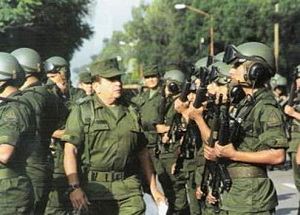
Beginning in 2004, the Creeperian Armed Forces resumed operation aimed against Mara Salvatrucha. The infamous Motion for the Eradication of Mara Salvatrucha resoundingly passed in the Council of Mayors by a unanimous vote and was signed and put into law by Alexander II on June 1, 2004. The motion put into effect a six month period where the Creeperian Armed Forces, the National Intelligence Directorate, the Creeperian National Police, the Salvadoran National Police, and the National Police of the Papal State are directed to immediately execute anyone who is a member of Mara Salvatrucha or even is a suspected member of Mara Salvatrucha on the spot of the arrest. The motion also called for the immediate execution of all members of Mara Salvatrucha currently incarcerated. The motion lead to the executions of 2,066 members of Mara Salvatrucha from June 1, 2004 through January 1, 2005. During the six month period, members of Mara Salvatrucha increased terrorist attacks on civilian and military targets making the war one of the deadliest in the world up to that point and the then second deadliest ongoing war, second only to the then ongoing Third Senvarian Insurgency. The motion was not renewed in January 2005 by the Council of Mayors.
Formation of FALANGE
On January 18, 2020, ten Creeperian death squads burned down the village of Dishna. The death squads proclaimed themselves to be the Creeperian Council for Order and Stability (CCOE), a coalition of ten Creeperian death squads. The leaders of the group, Generals Francisco Bajamande Rodríguez, Gustavo Duarte Carpio, José Koné Ochelo, and Raúl Lorenzana Méndez, declared their goal and the goal of the CCOE is to spread Creeperian Catholicism south and eradicate Deltinian Islam and Mara Salvatrucha. The group claimed to have 4,000 members.
The ten leaders of the Creeperian Council for Order and Stability, Francisco Bajamande Rodríguez, Felix Semprún Saelices, José Koné Ochelo, Sebastián Carvallo González, Elías Carballal Aguayo, Gustavo Duarte Carpio, Máximo París Alcocer, Salvador Velázquez Barrueco, Raúl Lorenzana Méndez, and Álvaro Bienvenida Cambeiro, broadcasted a message across Creeperopolis. They declared that the name of the CCOE was officially changed to the Fuerzas Armadas de Liberación Antideltiniano – Guerra de Eliminación (Anti-Deltinian Armed Forces of Liberation - War of Elimination), abbreviated as FALANGE. The force will continue its crusade to cleanse Creeperopolis of the Deltinian and Mara threat.
Execution of Alexander Ramírez Umaña
The Creeperian government officially revealed that Alexander Ramírez Umaña, the hated leader of the criminal gang known as Mara Salvatrucha, was captured in a DINA raid on February 3, 2020. The announcement brought joy to Creeperans across the country as the gang has been responsible for hundreds of thousands of deaths of innocent Creeperans. The deadly ongoing Mara War is a constant reminder of the violence the gang is responsible of. A public execution was scheduled for February 29, 2020, the day following his capture. The date was decided as a way to deny members of Mara Salvatrucha a yearly day of remembrance of their leader's execution, as the next February 29 would fall in 2024. Alexander Ramírez Umaña was sentenced to death in absentia in 1999 on the following charges:
Leading a criminal organization, drug trafficking, robbery, larceny, human trafficking, extortion, murder, money laundering, prostitution, racketeering, battery, kidnapping, arms trafficking, waging war on the Empire, waging war on God.
An estimated 1.2 million angry Creeperans from San Salvador arrived at the San Salvador Imperial Palace where the public execution was scheduled. Ramírez Umaña was originally scheduled to be executed by hanging, but Emperor Alexander II overruled the method and instead opted for an execution via firing squad. He cited "good behavior and cooperation while in captivity" as the reasoning for handing down a more merciful execution. Alexander Ramírez Umaña was executed via firing squad at 4:13pm SST.
In preparation for expected gang violence in the wake of the announcement and execution, 190,000 soldiers were deployed to combat any gang protests or riots. As expected, gang members began inciting violence. An estimated 114 people died in the hour following the execution as a direct connection to gang violence.
Gustavo Duarte Carpio, leader of the Militarist Nationalist Front (FRENAMI, Sombra Negra), applauded the execution and congratulated the Creeperian government on delivering justice to the people of Creeperopolis. After the announcement, FRENAMI burned a Deltinian village, killed 17 villagers, and kidnapped 4 children to train them to be child soldiers within the ranks of the Sombra Negra. Duarte Carpio assured the government that the FALANGE would be able to complete the extermination of the Deltinians soon.
Mara Salvatrucha named Román Saavedra Saelices as its new leader. Saavedra Saelices vowed to topple the monarchy.
Death of Román Saavedra Saelices
On March 20, 2020, the Creeperian National Police announced that Román Saavedra Saelices, the leader of Mara Salvatrucha, was killed in a gun fight with police in Tuxtla Martínez, Zapatista. The gang declared that Ismael Zambada García was their new leader and that the gang will never surrender in the war against the government.
Creeperian Government Forces
Political Support and Leadership
Creeperian political support has evolved and changed over the course of the war. Since 1979, Creeperopolis has had four Emperors, two Ministers of Defense, three legislative systems, and three forms of the Creeperian Initiative. Excluding the period of the October 16 Regime, all forms of the Emperor, Minister of Defense, legislature, and Initiative have been vocal supporters of the war.
Armed Forces
The Creeperian Armed Forces (Creeperian Spanish: Fuerzas Armadas Creeperiano, FAC) are the military forces of Creeperopolis. It consists of the Army, Navy, Air Force, and Imperial Guard. All four brances are currently supporting the war with the Creeperian Army and Creeperian Air Force taking the largest roles in the war.
National Intelligence Directorate
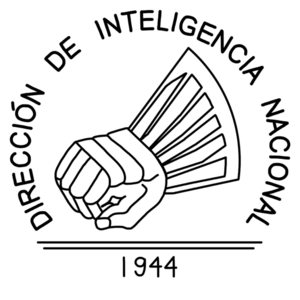
The Dirreción de Inteligencia Nacional (National Intelligence Directorate), abbreviated DINA, is the secret police of Creeperopolis and its vassals. The DINA is headed by the Chief of the DINA who is also the Minister of Defense. The DINA is essential in carrying out raids and operations to capture high ranking members of Mara Salvatrucha.
The DINA is notorious inside and outside of Creeperopolis for its human rights abuses.
Its record during the civil war is marked by uncountable cases of torture and execution without a trial. No DINA agents have ever been taken to court for war crimes or crimes against humanity. The DINA is also believed to be one of the most, if not the, most corrupt government agency of Creeperopolis.
Augusto Cabañeras Gutiérrez has become one of the most powerful men in Creeperopolis due to his leadership of the Creeperian Army and the DINA, and he uses his essentially unchecked power to carry out whatever he wishes through the DINA without consequences for the human rights violations committed.
The DINA continues its extensive human rights violations, to, in the words of Augusto Cabañeras Gutiérrez:
"[E]radicate all traces of Communism, Atheism, Senvarian and Sonsatepanian nationalism, and any form anti-Creeperian, anti-Catholic, or anti-Fatherland behavior, thoughts, and actions to preserve Creeperopolis and its prosperity."
Police Forces
Creeperian National Police
The Creeperian National Police (Creeperian Spanish: Policía Nacional Creeperiano, abbreviated PNC) is the national police force of Creeperopolis. The Creeperian National Police is tasked with arresting gang members withing the territory of Creeperopolis. It is headed by Alexander Zorita Arboleda.
Salvadoran National Police
The Salvadoran National Police (Creeperian Spanish: Policía Nacional Salvadoreño, abbreviated PNS) is the national police force of El Salvador. The Salvadoran National Police is tasked with arresting gang members withing the territory of El Salvador. It is headed by Óliver Campos Barrueco.
National Police of the Papal State
The National Police of the Papal State (Creeperian Spanish: Policía Nacional del Estado Papal, abbreviated PNEP) is the national police force of State of the Church. The National Police of the Papal State is tasked with arresting gang members withing the territory of State of the Church. It is headed by Lucas Arboleda Illescas.
Mara Salvatrucha
Mara Salvatrucha, popularly known as MS, is an Creeperian criminal gang that originated in San Salvador, San Salvador, Creeperopolis in 1951. Originally, the gang was set up to raid stores and homes for basic living needs for young survivors of the Creeperian Civil War. Over time, the gang grew into a more traditional criminal organization. Mara Salvatrucha is defined by its cruelty and brutality.
The gang is currently active in many parts of Creeperopolis. Most members are Creeperans, Castillianans, Senvarians, Sonsatepanians, and Deltinians. As a national gang, its history is closely tied to Creeperian history. In 1979, the gang went to war with the Creeperian government in the Mara War. It's allies were the Senvarian Liberation Front and the Militarist Front for National Liberation while the organization were active.
Paramilitaries and Death Squads
Armed Resistence Militia for Creeperopolis

Lead by General Francisco Bajamande Rodríguez, the Armed Resistence Militia for Creeperopolis is a death squad which seeks the extermination of all members of the gang known as Mara Salvatrucha. Founded in 1970, the Armed Resistence Militia for Creeperopolis is feared by members of Mara Salvatrucha aswell as Deltinians and Senvarians.
The group's official name is the Milicia Revolucionario Armada Creeperiano in Creeperian Spanish and is abbreviated MIRAC.
The death squad is the second oldest Creeperian death squad having been founded in 1970, second only to the Militarist Nationalist Front which was founded in 1940 during the Creeperian Civil War.
Creeperian Armed Nationalist Front

Lead by General Felix Semprún Saelices, the Creeperian Armed Nationalist Front is a death squad which seeks the elimination of the influcence of Mara Salvatrucha and the Senvarian Liberation Front in Creeperopolis. Founded in 1989, the Creeperian Armed Nationalist Front is feared by members of Mara Salvatrucha aswell as Deltinians and Senvarians and was founded as a direct result of the Mara War.
The group's official name is the Frente Nacionalista Armada Creeperiano in Creeperian Spanish and is abbreviated FRENARC.
The death squad is the youngest Creeperian death squad having been founded in 1989.
Creeperian Catholic Protection Army
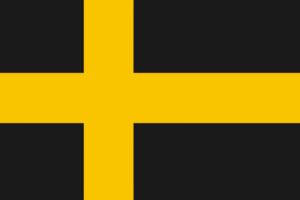
Lead by General José Koné Ochelo, the Creeperian Catholic Protection Army is a fundamentalist Creeperian Catholic death squad. Founded in 1993, the Creeperian Catholic Protection Army is feared by Deltinians and Senvarian-Sonsatepanians, the primary targets of the death squad. The death squad also targets gang members of Mara Salvatrucha.
The group's official name is the Creeperian Catholic Protection Army (Ejército Católico Creeperiano de Proteccion, abbreviated ECCP), although it is also called the Lord's Protection Army, Ejército de Proteccion del Señor (EPS) in Creeperian Spanish.
The group holds many things in common with the Lyoan Holy Resistance Movement.
Creeperian Revolutionary Militarist Patriotic Front

Lead by General Sebastián Carvallo González, the Creeperian Revolutionary Militarist Patriotic Front is a death squad which seeks the elimination of the influcence of Mara Salvatrucha and the Senvarian Liberation Front in Creeperopolis and claims that it will uphold Creeperian Nationalism. Founded in 1983, the Creeperian Revolutionary Militarist Patriotic Front is feared by members of Mara Salvatrucha aswell as Deltinians and Senvarians and was founded as a direct result of the Mara War.
The group's official name is the Frente Patriotico Militarista Revolucionario Creeperiano in Creeperian Spanish and is abbreviated FPMRC.
The death squad is the fifth oldest Creeperian death squad having been founded in 1983.
Militarist Nationalist Army
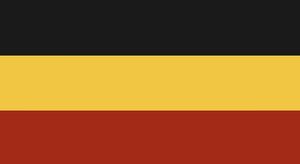
Formerly lead by General Elías Carballal Aguayo and now lead by Óscar Sanz Martí, the Militarist Nationalist Army is a death squad which seeks the elimination of the influcence of Mara Salvatrucha and all its members. Founded in 1979, the Militarist Nationalist Army is feared by members of Mara Salvatrucha aswell as Deltinians and was founded as a direct result of the Mara War.
The group's official name is the Ejército Nacionalista Militarista in Creeperian Spanish and is abbreviated ENAMI.
The death squad is the third oldest Creeperian death squad having been founded in 1979.
Its leader, Elías Carballal Aguayo, was a former Colonel in the Creeperian Army before he split from the army and established the Militarist Nationalist Army. He was killed on March 29, 2020, by the Creeperian government and replaced by Óscar Sanz Martí.
Militarist Nationalist Front

Lead by infamous General Gustavo Romero Duarte Carpio, the Militarist Nationalist Front is the most feared and most brutal Creeperian death squad. The Militarist Nationalist Front, abbreviated FRENAMI (for Frente Nacionalista Militarista in Creeperian Spanish) and also called Sombra Negra, was founded in 1940 during the Dark Years of the Creeperian Civil War.
During the Creeperian Civil War and under the leadership of Adolfo Rivera López, the death squad was allied with the Catholic Imperial Restoration Council, the Romerists, and fought relentlessly against the National Council for Peace and Order, the Miguelists. FRENAMI declared its goal was to erradicated Communism and to expel the Senvarians and Sonsatepanians from Creeperopolis.
Following the conclusion of the civil war, Rivera López refused to disarm in the death squad's new mission to eradicate Senvarians and Sonsatepanians. Until his death in 1981, FRENAMI continued to attack Senvarian and Sonsatepanian villages, occasionally clashing with the Creeperian Army and occasionally attacking Deltinian villages.
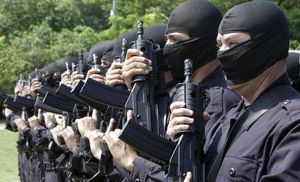
In 1979, the Mara War erupted in Creeperopolis with the gang, Mara Salvatrucha militarizing itself to fight the government. The Sombra Negra declared war on Mara Salvatrucha and began to torture and execute gang members, seeing them as subhuman, a belief shared with Creeperian civilians and the other nine death squads. However, when the Castillianan Insurgency began in 1980 with the Castillianan National Council of Reorganization and its army, the Militarist Front for National Liberation declaring independence for Castilliano, FRENAMI refused to fight as it saw Castillianans as Creeperian brothers.
Under Enrique Rivera López, FRENAMI continued its war against the Senvarians and Sonsatepanians. He was assassinated on April 23, 1992, allowing his second-in-command, Gustavo Duarte Carpio, to become its leader. Like his predecessors, the death squad continued to burn and attack Senvarian and Sonsatepanian villages.
However, with the erruption of the Deltinian Insurgency and the rise of several insurgent rebel groups, FRENAMI, along with the Creeperian Armed Forces, Senvarian Liberation Front, and Militarist Front for National Liberation established a cease fire to combat the Deltinians a group that all four had rivalries with for a thousand years. The four formed and planned Operación Justicia, a joint-invasion into Deltino.
Militarist Nationalist Milita

Formerly lead by General Máximo París Alcocer and now lead by Ernesto Abellán Ureña, the Militarist Nationalist Militia is a death squad which seeks the elimination of the influcence of Mara Salvatrucha and all its members and claims to uphold Creeperian Nationalism. Founded in 1980, the Militarist Nationalist Militia is feared by members of Mara Salvatrucha aswell as Deltinians and was founded as a direct result of the Mara War.
The group's official name is the Milicia Nacionalista Militarista in Creeperian Spanish and is abbreviated MINAMI.
The death squad is the fourth oldest Creeperian death squad having been founded in 1980.
Its leader, Máximo París Alcocer, was a former Colonel in the Creeperian Army before he split from the army and established the Militarist Nationalist Militia. He was killed by the Creeperian government on March 29, 2020, and replaced by Ernesto Abellán Ureña.
Militarist Revolutionary Front

Lead by General Salvador Velázquez Barrueco, the Militarist Revolutionary Front is a death squad which seeks the elimination of the influcence of Mara Salvatrucha and all its members. Founded in 1985, the Militarist Revolutionary Front is feared by members of Mara Salvatrucha aswell as Deltinians and was founded as a direct result of the Mara War.
The group's official name is the Frente Revolucionario Militarista in Creeperian Spanish and is abbreviated FREMI.
The death squad is the third youngest Creeperian death squad having been founded in 1985.
Its leader, Salvador Velázquez Barrueco, was abducted by the Militarist Revolutionary Front when he was a child but rose through the ranks to eventually become the death squad's leader after the death of Rubén Chicote Obregón.
Movement of Organized Nationalist Action

Lead by General Raúl Lorenzana Méndez, the Mano Blanca's primary target before the erruption of the Deltinian Insurgency was members of Mara Salvatrucha. Based in Zapatista and founded in 1983, the Mano Blanca engaged in warfare against Mara Salvatrucha during the Mara War. The group spread wherever MS spread from Zapatista to San Pedro to Helam.
The banner of the Mano Blanca stands for Martirio, Liberación, Nacionalismo (translated into Lyoan: Martyrdom, Liberation, Natioanlism). Like the other nine death squads and Creeperian civilians, the Mano Blanca sees the members of Mara Salvatrucha as subhumans.
The Mano Blanca's official name is not well known across Creeperopolis. It's official name is the Movement of Organized Nationalist Action (Movimiento de Acción Nacionalista Organizado in Creeperian Spanish, the reason the group is called Mano Blanca, as its abbreviation is MANO). Its naming Mano Blanca (White Hand) instead of Mano Negra (Black Hand) is unknown, since most Creeperian death squads, including Mano Blanca, use black as the colors of their uniforms.
Revolutionary Militia for Creeperian Sovereignty
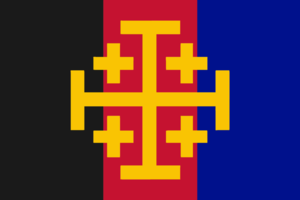
Lead by General Álvaro Bienvenida Cambeiro, the Revolutionary Militia for Creeperian Sovereignty is a death squad which seeks the elimination of the influcence of Mara Salvatrucha and all its members and the group claims to uphold Creeperian Nationalism. Founded in 1983, the Revolutionary Militia for Creeperian Sovereignty is feared by members of Mara Salvatrucha aswell as Deltinians and was founded as a direct result of the Mara War.
The group's official name is the Milicia Revolucionario por'Soberanía Creeperiano in Creeperian Spanish and is abbreviated MIRESOC.
The death squad is the fourth youngest Creeperian death squad having been founded in 1983.
Its leader, Álvaro Bienvenida Cambeiro, was abducted by the Revolutionary Militia for Creeperian Sovereignty when he was a child but rose through the ranks to eventually become the death squad's leader after the death of Bernabé Covarrubias Leoz.
Leadership
The ten death squads organized themselves into the Anti-Deltinian Armed Forces of Liberation - War of Elimination. It is a council and the council is composed of the ten leaders of the ten deaths squads. Most of these men have not been seen or photographed properly since the 1980's and 1990's when they formed their respective death squad or assumed power in said death squad.
Of the ten, Elías Carballal Aguayo and Máximo París Alcocer were former Colonels in the Creeperian Army, but they were assassianted by the Creeperian government on March 29, 2020, leading to their replacement with Óscar Sanz Martí and Ernesto Abellán Ureña, respectively. The remaining eight all grew up as civilians. Of the eight who grew up as civilians, Gustavo Duarte Carpio, Salvador Velázquez Barrueco, and Álvaro Bienvenida Cambeiro were kidnapped as children into death squads, Felix Semprún Saelices and Francisco Bajamande Rodríguez were former police officers, Raúl Lorenzana Méndez and Sebastián Carvallo González were farmers, and José Koné Ochelo was a Creeperian Catholic priest.
- Cateyano Carpio -- Comandante Marcial.jpg
Francisco Bajamande Rodríguez
January 17, 2020-present MIRAC
MIRAC Felix Semprún Saelices
January 17, 2020-present FRENARC
FRENARCJosé Koné Ochelo
January 17, 2020-present ECCP
ECCPSebastián Carvallo González
January 17, 2020-present FPMRC
FPMRCÓscar Sanz Martí
March 29, 2020-present ENAMI
ENAMIGustavo Duarte Carpio
January 17, 2020-present FRENAMI
FRENAMIErnesto Abellán Ureña
March 29, 2020-present MINAMI
MINAMI- Salvador Velázquez Barrueco.jpg
Salvador Velázquez Barrueco
January 17, 2020-present FREMI
FREMI Raúl Lorenzana Méndez
January 17, 2020-present MANO
MANOÁlvaro Bienvenida Cambeiro
January 17, 2020-present MIRESOC
MIRESOC
Propaganda
Government
Propaganda has been used in Creeperopolis since the early years of the Second Parliamentary Era to sway public opinion. Propaganda was a crucial instrument for acquiring and maintaining power, and for the growth and maintaining of support for the Catholic Imperial Restoration Council and the National Council for Peace and Order. Propaganda today is used by the Creeperian government to justify its authority, programs, and encourage popular support for the monarchy and army. Propaganda has been utilized by the government to portray Mara Salvatrucha as the reincarnation of the National Council for Peace and Order and as a force commanded by Satan.
Mara Salvatrucha
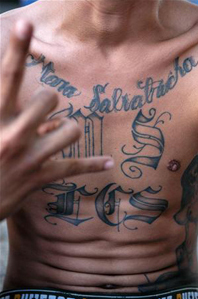
Mara Salvatrucha uses propaganda through media and scare tactics to gain more control of its people and in many cases corrupting the government. The main goals are to glorify actions of the drug cartels and their lifestyle, gain control of the Creeperian society to the highest extent possible, and to recruit new, educated, high class members to increase their power even further. Mara Salvatrucha use of propaganda and scare tactics are used in precise, complex and clever ways to get the most out of every action, resulting in their enormous power.
Mara Salvatrucha has adopted the word "mara" itself to pertain to anything relating to itself, and it has spread to be a part of everyday Creeperian slang. Maracultura is the criminal culture of Mara Salvatrucha. There are music, television shows, literature, beverages, food, and architecture that all have been branded "mara," which the Creeperian government is making efforts to ban. Maracorridos are Creeperian country songs glorifying the lifestyles of drug lords. They are typically produced by artists working with or being paid by Mara Salvatrucha. Mara Salvatrucha hangs mara-banners up around cities to advertise themselves and threaten the government. They also distribute mara-flyers, used for the same purposes as the mara-banners, by handing them out to people, scattering and posting them around cities, and leaving them near the bodies of homicide victims.
Mara Salvatrucha's use of propaganda through new media has increased significantly as the primary source of connection with the people. It's seen as a war tactic against the Creeperian government, taking its people and putting them against themselves. Many times cartels use bribery or threats against journalists and publications to report the cartels in a good light. They also bribe or threaten members of the local law enforcement to look the other way when drug trafficking or arms trafficking crimes are committed.
The Creeperian government hands down heavy punishments for producing, distributing, or willingly viewing Mara Salvatrucha propaganda. Producing propaganda is handed down a 10 year prison sentence, distributing propaganda is handed a 20 year prison sentence, and willingly viewing propaganda is handed a 15 year prison sentence. The government is actively banning and erasing music, television shows, literature, beverages, food, and architecture that are deemed to be propaganda used by Mara Salvatrucha.
Mara Salvatrucha's use of propaganda also takes a psychological toll on the people of Creeperopolis, including the Creeperian culture and their society as a whole. Fear has permeated into the daily life of an entire country through the use of scare tactics, murders, their symbolism, and bombings. Threats are one of Mara Salvatrucha's most effective tools and the credibility behind them. When they threaten someone, they usually carry it through. These threats are a form of psychological warfare because either through coercion or scare tactics they are influencing their targets perceptions, attitudes, and behavior. The violence includes everything from beheadings, kidnappings, assassinations, bombings, and grenades. Many of the dead found show signs of torture, such as their hands tied behind their back and being set on fire. Some individuals have been daubed with axle grease and stuffed into a tank or oil drum and then set to fire. Another popular tactic is dropping victims in homemade acid. Bodies are often found dumped along the road or in mass graves. Many killings and the use of dead bodies as symbols often happen during social events when the victim least expects it. Mara Salvatrucha's use extreme violence on bodies to portray a certain message. For example, decapitations often are supposed to show that the victim did not fulfill their job or was part of two sides of the conflict.
Some types of psychological warfare include closing of public establishments, roadblocks and threats to public officials. Society is always aware of the drug cartels presence, in places where many Creeperans may feel safe like in schools and medical clinics. Another way used to put fear into the Creeperian people are unexpected roadblocks. It stops people like the military and the police from taking control of traffic that may as well be controlled by Mara Salvatrucha. The fear that is put into the Creeperian people leads to a decreased number of people putting effort into stopping the drug cartels, since most are too scared to do so. The people living through the Mara War are living through constant insecurity, causing significant psychological toll on these individuals. Another part of the psychological toll on the people is the lack of freedom of speech. If an individual expresses themselves in a way that Mara Salvatrucha would not appreciate, as for example writing about their secret actions, their life and the life of all their loved ones will be at risk. The ways of the Creeperian people are extremely affected by this issue since its a big part of everyday life. The culture changes significantly as well since many Creeperans live in constant fear, unable to operate some customs that was previously the way of life.
Mara Salvatrucha also uses bribes and extortion as a means to keeping their business running. They use the motto "plata o plomo" meaning silver or lead, give them money and protection or face death. Kidnappings have become an extortion scheme. Mara Salvatrucha charges a war tax within their territory and if someone can't or won't pay the tax, they or a family member is kidnapped until they can pay.
Effects in Creeperopolis
Casualties
It is often not clear what deaths are part of the Mara War versus general criminal homicides, and different sources give different estimates. Casualties are often measured indirectly by estimated total deaths from organized crime in Creeperopolis. Military deaths are estimated to be around 170,000 dead, however, including civilian deaths, this amounts to about 1,730,000 on the low end to about 2,394,000 on the high end total dead in the years 1979-2019.
Government Corruption
Mara Salvatrucha advances its operations, in part, by corrupting or intimidating law enforcement officials. Creeperian municipal, departmental, and national government officials, along with the police forces, often work together with Mara Salvatrucha in an organized network of corruption.
Although the Creeperian government has made concerted efforts to reduce corruption with Mara Salvatrucha in recent years, going as far as to label corruption with the gang as treason, thus making it punishable by death, it remains a serious problem. Some agents of the National Intelligence Directorate (DINA) are believed to work as enforcers for Mara Salvatrucha.
Impact on Human Rights
The Creeperian government officially holds that members of Mara Salvatrucha do not have human rights.
On August 19, 1993, the Motion on the Situation Regarding Mara Salvatrucha was a motion passed by a majority of the vote in the Council of Mayors which was signed by Emperor Romero III which mandated the removal of citizenship of all members of Mara Salvatrucha and mandated that all members of Mara Salvatrucha had no constitutional rights.
Several sources claim that the Creeperian government, specifically the National Intelligence Directorate (DINA) commit various human rights abuses and crimes against humanity against members of Mara Salvatrucha.[citation needed]
Massacres
The Mara War has seen several massacres during the course of the war, with the most notorious massacres being the Tuxtla Martínez Massacre, the Massacre of the Basilica of Christ the King, and the Mapastepec Massacre.
Effects Internationally
Several nations have been affected either directly or indirectly by the Mara War.
Quebecshire and Lyoa support the government against the gang while, New Gandor and Terranihil are accused of supporting Mara Salvatrucha in its terrorist operations, accusations all three deny. Meanwhile, drugs are trafficked to the naitons of Lyoa, Rakeo, Terranihil, Malgax, San Carlos Islands, and Willdavie.
